#bats of Central America
Explore tagged Tumblr posts
Text
DEPLOY THE SKRUNKLE
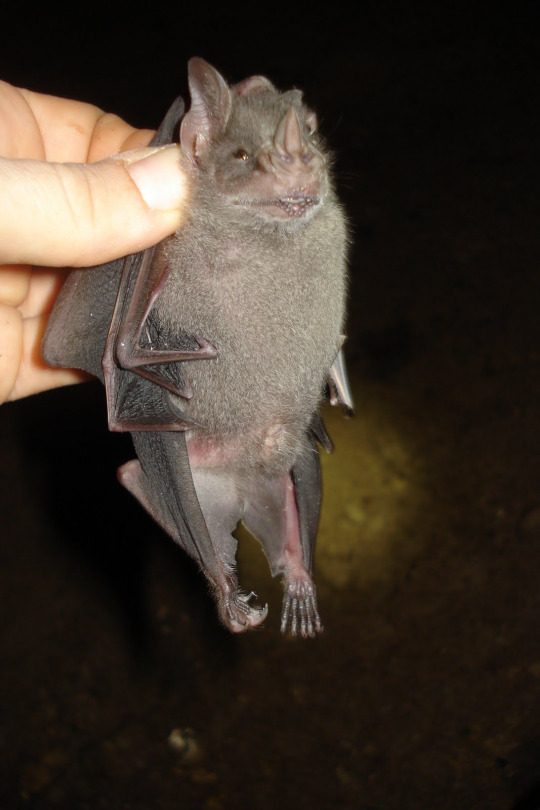
#Jamaican Fruit Bat#Bats of Central America#bats of South America#bat of the day#daily bat#bat#bats#batposting#cute bats#cute animals#You love to see them#DEPLOY THEM#THE SKRUNKLY#silly guy
10K notes
·
View notes
Text

3K notes
·
View notes
Text

Northern Ghost Bat (Diclidurus albus), family Emballonuridae, found in Central and South America
photograph by Michael Autumn
#bat#ghost bat#diclidurus#emballonuridae#chiroptera#mammal#animals#nature#central america#south america
1K notes
·
View notes
Text



Come Have a Bite with the Vampire Bat!
Desmodus rotundus, better known as the common vampire bat, is a species of leaf-nosed bat native to Central and South America, as well as parts of the Caribbean. They are found primarily in tropical forests, particularly rainforests, but can also roam into scrubland and agricultural areas. Common vampire bats roost in hollow trees, caves, and abandoned buildings, making them a common sight in or near urban areas.
As their name implies, the common vampire bat feeds exclusively on blood, particularly those of mammals. In the wild they will feed on large animals like tapirs, but they more frequently go after domesticated animals like cattle, goats, and horses. However, when ideal prey is lacking they will also feed off lizards, turtles, snakes, toads, and crocodiles. Like most bats, D. rotundus uses echolocation to find prey. Then, special heat sensors in the nose help it to detect blood vessels close to the skin; it then bites open a small flap of the skin and drinks its fill. Its saliva contains both painkillers and anticoagulents, so victims seldom notice their host until after it has fed. Predators of D. rotundus include owls, hawks, and eagles.
Common vampire bats live in colonies of about 100 individuals, although colonies consisting of up to 1,000 individuals have been recorded. Within these colonies, males and females roost separately; females cluster in groups of 8-20, while males roost individually and guard territories against other males. However, D. rotundus is highly social, and males and females will both groom members of the same and opposite sex. This grooming can even extend to homosexual behaviours like genital licking, which is thought to reinforce hierarchies and strengthen social bonds.
D. rotundus can breed year-round, but females only raise one pup per year. Males typically mate with females in or near their defended territories. Afterwards, females carry their pregnancy for about 7 months before giving birth to a single pup. These young feed on their mother's milk for their first month; during this time, other adult females will often provide the mother with excess blood as she cannot hunt for herself. Once the pup is weaned they begin recieving blood from their mothers, and at four months they begin accompanying her on hunts. At about five months they are fully independent; females will remain in their mother's roost while males will leave to establish their own territories. Young become fully mature at about a year old, and adults may live to 12 years in the wild.
The common vampire bat is relatively plain looking, as far as bats go. They are generally gray or brown, with darker fur over their backs and dark brown or black membranes along their wings. The nose has a distinct triangle shape, which houses special heat-sensing organs. Likewise, the ears are large and triangular, used for echolocation. Adults are rather small, about 9 cm (3.5 in) long with an average wingspan of 18 cm (7 in) and a weight of 25–40 grams (2 oz).
Conservation status: The IUCN lists D. rotundus as Least Concern. In fact, populations of the common vampire bat are increasing due to the abundance of livestock as a food source.
If you like what I do, consider buying me a ko-fi!
Photos
Jose Gabriel Martinez Fonseca
Sheri & Brock Fenton
Nicolas Reusens
#common vampire bat#Chiroptera#Phyllostomidae#vampire bats#leaf-nosed bats#bats#mammals#tropical forests#tropical forest mammals#tropical rainforests#tropical rainforest mammals#urban fauna#urban mammals#central america#south america#queer fauna#nature is queer#animal facts#biology#zoology#ecology
225 notes
·
View notes
Text

What a long nose I have? The better to lick my dear flowers!
Lesser Long-nosed Bat (Leptonycteris yerbabuenae)
Southwestern US, Mexico, and Central America
Status: Delisted as Recovered in the US, Special Concern in Mexico
#bat#long-nosed bat#mammal#bat art#animal art#animal illustration#artists on tumblr#north america#central america#usa#mexico#guatemala#honduras#el salvador
24 notes
·
View notes
Video
A face only a mother could love by Andrew Snyder Via Flickr: Wrinkle-faced bat (Centurio senex) from Cusuco National Park, Honduras, Central America. June 2010.
#bat#wrinkle faced bat#centurio senex#centurio#senex#murcielago#rabies#cusuco#cusuco national park#honduras#central america#asnyder5#Andrew Snyder#jungle#biology#ecology#conservation#tropics#forest#wildlife#nature#natural#Andrew M. Snyder#Pot-of-Gold#operation#wallacea#Operation Wallacea#science#animals#life
7 notes
·
View notes
Text
Animal of the day for October 26: Common Vampire Bat (Species Desmodus rotundus)

A fitting animal for this time of year. Vampire Bats, as their name suggests, primarily feed on the blood of other animals. For some reason they prefer domesticated livestock over wild prey, and prefer horses the most. Unlike fictional vampires who just suck the blood out of your body, a Vampire Bat feeds by biting its prey in an area where blood flows a lot, and then licking the bleeding wound.
10 notes
·
View notes
Text
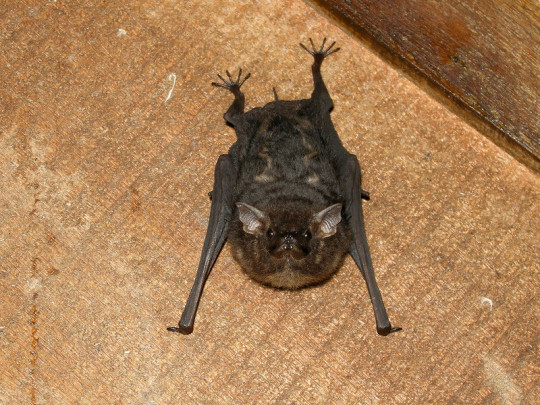
A sac-winged bat (Saccopteryx sp.) in Costa Rica
by Frank Vassen
#sac winged bat#bats#saccopteryx#Emballonuridae#chiroptera#mammalia#chordata#wildlife: costa rica#wildlife: central america
125 notes
·
View notes
Text
Checking in

He hopes you're well
#He hopes you're well#Black myotis#Bats of Central America#bats of south america#bat of the day#daily bat#bat#bats#batposting#cute bats#cute animals#look at them#Checking in
653 notes
·
View notes
Note
Hi,if you’re not busy can you write a fic of Cod characters with a cia agent gf ?
yes ofc! yk i love a good little government agent gf moment :)
a double life
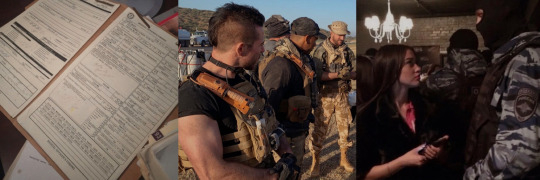
┊ ⋆ ┊ . ┊ ┊┊ ⋆ ┊ . ┊ ┊┊ ⋆ ┊ . ┊ ┊┊ ⋆ ┊ . ┊ ┊┊ ⋆ ┊ . ┊ ┊┊
summary: From hidden occupations to a particular set of skill sets, the 141 learns to adapt to having a girlfriend who has all the right qualifications (and who could completely kick their ass).
pairing: Task Force 141 x fem!reader
warnings: swearing, mentions of weapons/violence
┊ ⋆ ┊ . ┊ ┊┊ ⋆ ┊ . ┊ ┊┊ ⋆ ┊ . ┊ ┊┊ ⋆ ┊ . ┊ ┊┊ ⋆ ┊ . ┊ ┊┊
price
"Sorry I can't be there to meet you, Price," Laswell spoke over the web camera feed, "got tied up in South America." Price nodded as he held the bridge of his nose, Laswell had promised her best field agent to act as a point person for their mission in New Zealand. However, just the thought of some middle-aged retired veteran or worse yet, hot-shot rookie, made his headache pound even further. "She's a good one, Price," Laswell reassured, "skilled in practically every major language and the best marks in her physical fitness examination." "Yes Kate, I read her file, but it seems like you failed to include a photo-" He was interrupted by a sturdy knock at the door. "Looks like she's here."
As you cracked the door open, you practically dropped the files that sat in your arms. "What are you doing here?" Price asked jovially and you could feel the breath release from your sternum, "didn't expect an on-base visit like this." As the pieces began to fit together, you realized he didn't know what you were actually there for. "John, Kate sent me here," you whispered as you shut the door gently, "heard you're going to New Zealand." As the realization hit him like an oncoming train, you braced for impact. "You-you work for the CIA?" he asked almost foolishly and you nodded in response. "I did say I worked in Virginia," you corrected, "and you had to know my surprise visit yesterday wasn't just a spur-of-the-moment thing." Price could feel his headache reach a fever pitch as he reviewed your file again. "Then what's with the name?" he asked, "you lie about that too." You let out a laugh as you explained, "People have nicknames and mother's maiden names, John." As you sat back in your chair and crossed your legs, Price wondered what he had done for the universe to gift him you.
soap
Despite your initial reservations, Johnny was quite good at keeping your occupation vague and nonchalant in conversation. You were honest about your work in central intelligence and he took that secret to the grave. Your long-distance relationship was written off as you working in some company in DC and no one batted an eye at your occasional inference at military strategy or surveillance techniques. When you returned home, you would always be sure to show him extra appreciation for his covertness. "Tryna make me patriotic?" he would joke before you would kiss him and stifle his laughs.
However, he loved testing your skill set and seeing if you were as trained of an operative as your file read. "Let's see what they teach you over there, Bonnie," he joked as he lined up his sights at the air gun range. You refrained from kicking him as you stood back to watch him. You almost let out a laugh when you saw his small pellet ricochet just slightly off target. "Hmm and that's why Ghost is your long-range weapons specialist," you teased as he got up and switched positions. You breathed in as you looked down your sights and positioned your rifle towards the farthest target on the range. "You Americans, always so fucking cocky," he muttered under his breath before you quickly shut him up with a quick shot directly into the center of the target. The metal hen spun around widely at your expert marksmanship and you exhaled your held breath. You stood up and tried to size up your tall boyfriend. "Best 2/3?" you offered and you smiled as he kissed your forehead before ushering you out of the way to try again. "Fucking CIA training," he whispered as he got into position again. "You say something, you glorified sergeant?"
gaz
It was 4 am when you arose from the bed and leaned into Kyle, taking in his warmth and seeking refuge from the cold London air. You could always rely on your boyfriend to be your human-sized space heater. As you laid your head across his chest, you could feel him stir lightly. "Time to go already, love?" he asked with his eyes still closed and you muttered in confirmation. You always knew what challenges came with living so far away from the States but you had someone who made it all worth it. He kissed your forehead lightly as you rolled off the bed. You tried to quietly make your way to the bathroom to let him get some more hours of precious sleep but upon your return, it was clear Kyle was more awake than before.
"You sure you don't need me to drive you to the airport?" he offered yet again as you dressed quickly in dress slacks and a blouse. "MI6 is sending a car," you explained as you collected your overnight bag, "just try to get some sleep, my love. I'll text you when I land in Langley." Despite your soft kiss on the cheek, Kyle still pouted as you pulled away. "Don't understand why you can't be a liaison officer for us," he mumbled but you ruffled his hair slightly. "When the position becomes available, I'll be the first application on there," you smiled, doing a final check of your things, "just tell Price to write me a hell of a recommendation letter." With that, you shared another long kiss as you slightly cringed at his morning breath. "I'll be sure to say hi to the cybercrime analysis team for you, hopefully, they'll actually take my advice this time," you laughed before exiting out of your apartment and embracing the cold English air you had grown to love.
ghost
When the question arose of your occupation, you would always smile and defer to being just an "American government worker." However, you always knew Simon had more than just an inkling as to your occupation. When you spoke about military strategy, and combat techniques, or even had various conversations in different languages over the phone, it was clear to him that you were more than just a civilian. The shock didn't even resonate with him when you uttered the words, "Paramilitary Operations Officer," it all seemed to fall into place. He wouldn't bat an eye when it came to long stretches of days that you were in minimal contact with him. "I'll be back," you would reassure as you pulled on a dark hoodie and headed out the door with a bag. Simon would always be there to clean your wounds and ice your bruises.
It was a shock when Simon hadn't heard from you in a month. You had left in the middle of the day in a black Mercedes that disappeared off the English skyline. It was the unfortunate timing that he had been on leave when you left and there had been no word from Price regarding a new mission. Every morning, he would turn over in your king-sized bed expecting to see you smiling back at him. However, the days dragged on without any information meeting his ears. You could practically still picture his terrified face when you turned the key into the door and slammed your bag down. Simon paused upon seeing your blackened eye and wrapped knuckles. The eye bags on your delicate face further added worry to the situation. "Don't ask," you whispered as you fell into his chest, "intel was shit." That was all Simon needed to lift you gently and place you back on the couch. As he held you in his arms with an ice pack to your eye, you slightly pulled away from his touch. "I promised I would come back, didn't I?"
#task force 141 x reader#task force 141#cod x reader#call of duty modern warfare#cod mwii#modern warfare 2#simon riley x reader#simon ghost riley#call of duty#john soap mactavish#kyle gaz garrick#gaz x reader#soap x reader#price x reader#kyle garrick x reader#john price x reader#Johnny mactavish x reader#mw2 imagine#madebyizzie#izzie is writing
1K notes
·
View notes
Text

Hoary Bat (Lasiurus cinereus), family Vespertilionidae, breeds over most of North and Central America and overwinters in South America
photograph via: National Park Service
342 notes
·
View notes
Text
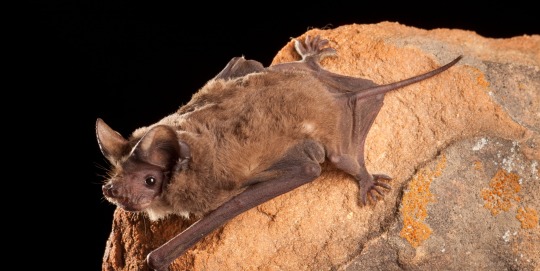
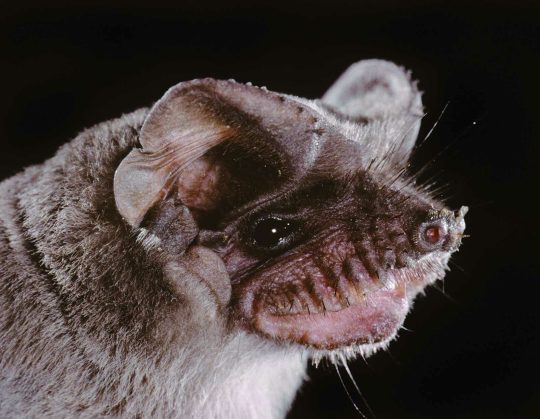
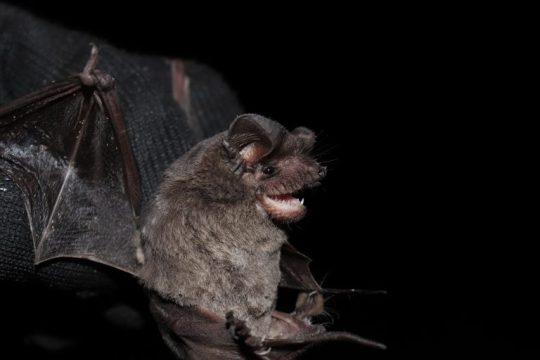
Fly Free with the Mexican Free-tailed Bat
Also known as the Brazilian free-tailed bat, guano bat, or Tadarida brasiliensis, this member of the order Chiroptera is one of the most widely-distributed New World bat species. They are common throughout the southern United States, Central America, and western South America. In many parts of the southern United States, the species is migratory and moves to Central America for the winter. They roost primarily in caves, but can also build nests in buildings; because of this, they can be found in a range of habitats including tropical and deciduous forests, mountains, deserts, and urban areas.
Like most bats, the Mexican free-tailed bat is nocturnal, emerging at sunset to hunt. They are primarily insectivores, and will travel great over 31 km (50 mi) to find food. In fact, this species holds the record for both the highest recorded flight altitude-- at 3.3 km (2 mi) high-- and the fastest flight speed-- an astounding 160 kph (99.4 mph)! That makes the Brazilian free-tailed bat the fastest mammal on Earth, although they can only achieve those top speeds in short bursts and with a good tail wind. Moving that fast can be useful, not only for covering great distances or catching insects, but for avoiding predators like raptors and owls. Young bats that can't fly may also be susceptible to opossums, skunks, and snakes.
The roosts of T. brasiliensis can be quite large; many contain several thousand individuals, while some have been recorded as housing more than a million. For this reason, communication is very important. Mexican free-tailed bats use echolocation to navigate and, for mothers, to locate their young. This species has over 15 distinct calls just for socialization. In addition, they can use their vocalizations to 'jam' the echolocation of other rival species and steal their prey.
Mating for the Brazilian free-tailed bat occurs once a year in the spring. Females gather in large maternity groups, while males mark out a territory by urinating and emitting loud vocalizations. Once a pair mates, the two separate- often to seek out another partner. Gestation lasts 11-12 weeks, and once females give birth they leave their offspring in a group of pups known as a creche, that is cared for communally. The pups take 4-7 weeks to be weaned, and after they learn to fly they join the larger roost as independent adults. However, females take up to 9 months to become sexually mature, while males may take as long as 2 years. In the wild, an individual may live as long as 8 years.
Size-wise, T. brasiliensis is on the smaller side of the bat group. Most individuals are around 9 cm (3.5 in) in length and weigh around 7–12 g (0.25–0.42 oz), with a wingspan of 28 cm (11 in). Females tend to be slightly heavier, but not larger otherwise. The tail of the Mexican free-tailed bat accounts for nearly half its total body length, and is unconnected by the thin membrane that makes up its wings (the uropatagium)-- hence the name 'free-tailed'. The ears are large and rounded, to assist with echolocation, and the muzzle is heavily wrinkled to give them a wider gape when catching bugs in mid-air. The Brazilian free-tailed bat's fur is dark brown or gray, with no distinguishing features save the long, white bristles around their feet.
Conservation status: The IUCN has classified the Mexican free-tailed bat as Near Threatened. However, populations are declining due to habitat destruction and susceptibility to a fungus known as white nose syndrome. Governments in the southern United States and Mexico, as well as private NGOs like Bat Conservation International, have established laws and conservation areas to protect the species.
If you like what I do, consider leaving a tip or buying me a kofi!
Photos
Michael Durham
Merlin D. Tuttle
Carlos Russi
#mexican free-tailed bat#Chiroptera#Molossidae#free-tailed bats#bats#mammals#generalist mammals#tropical forest mammals#deciduous forest mammals#wetland mammals#desert mammals#north america#southern north america#central america#south america#western south america
121 notes
·
View notes
Photo

Atahualpa
Atahualpa (Atawallpa) was the last ruler of the Inca Empire. He reigned from 1532 until his capture and execution by the invading Spanish forces led by Francisco Pizarro in 1533. The troubled Incas had suffered six years of damaging civil war and Atahualpa was only just enjoying his ascendancy to the throne when the Spanish arrived to turn the Inca world upside down.
Further weakened by European-introduced diseases, which wiped out millions, the Incas could do nothing against the better-armed invaders, even if there were only 168 of them. The Conquistadors were utterly ruthless and they would stop at nothing to gain the fabulous riches of the Americas' largest-ever empire.
Civil War & Succession
Atahualpa's father Wayna Qhapaq died in 1528 of smallpox, the most distinguished victim of the epidemic of European diseases which had spread from central America even faster than the foreign invaders themselves could manage. This epidemic killed a staggering 65-90% of the native population. When Wayna Qhapaq died without choosing a second heir (his first choice Ninan Cuyuchi also died of smallpox) Atahualpa battled for the throne with his half-brother Waskar (or Huascar) in a hugely damaging civil war which the Spanish would be only too glad to take advantage of when they arrived on Inca territory in 1532. Atahualpa was based in the northern capital at Quito while Waskar was at the Inca capital at Cuzco. After diplomatic relations soured between the two brothers, open warfare broke out in the north. There followed a series of battles between the Inca nobility which was costly to both sides until, after six years of fighting, Atahualpa finally prevailed.
By the time Spanish arrived, Atahualpa had managed to capture Waskar but the factions which had deeply split the empire remained. Waskar was imprisoned and his kin-group was killed, as were those who had supported him. Atahualpa even killed historians and destroyed the Inca quipu records. This was to be a total renewal, what the Incas called a pachakuti or 'turning over of time and space', an epoch-changing event which the Incas believed periodically occurred through the ages. What Atahualpa did not know was that another pachakuti was less than a year away, and this time he would be its victim.
Atahualpa's reign may have been brief but, as the Sapa ('Unique') Inca, he lived a life of extreme luxury. Drinking from gold cups, wearing silver-soled sandals and treated as a manifestation of the Sun god Inti on earth, Atahualpa was the head of the largest and richest empire the Americas had ever seen. His taste for opulence was chronicled by the Spanish who said that he once ordered a cloak made only from bat skins. As the Inca king and member of the royal blood line, he had the right to wear even more gold jewellery than the already over-laden nobility. His regalia included a feather headband (Ilauto), a golden mace (champi), and king-size golden ear-spools. The monarch travelled on a gold and silver litter further embellished with parrot feathers. He was fed food by a servant, and anything the royal person touched was collected and burnt in an annual ceremony to ward off witchcraft. If ever there was a pampered ruler it was the Sapa Inca of ancient Peru.
Continue reading...
94 notes
·
View notes
Text
round three: A Brown Bat Wins Either Way
Big Brown Bat (Eptesicus fuscus) - This species has a wide range, found throughout North America, Central America, and the northern portion of South America. This species is a significant predator of agricultural pests. A 1995 study found that, per year, a colony of 150 big brown bats in Indiana or Illinois consumes 600,000 cucumber beetles, 194,000 scarab beetles, 158,000 leafhoppers, and 335,000 shield bugs—all of which cause serious agricultural damage.

image description: a big brown bat on a rock image source: John MacGregor (Land Between the Lakes KY/TN), via wikipedia
Little Brown Bat (Myotis lucifugus) - Despite their name, they are not related to the Big Brown Bat. This species lives throughout much of North America, though historically the largest colonies were found in the more mountainous regions of the eastern United States. This species has been hit hard by White Nose Syndrome, with dire predictions in 2010 suggesting that the species would almost certainly be locally extinct in the Northeastern United States by 2026. The species currently seems to be hanging on with the persistence of small localized populations, though, and as recently as 2023, there seems to be signs of hope that if given enough time and continued protection on the Endangered species list, this species may recover.

image description: a little brown bat being held up for a picture by a researcher wearing white gloves image source: SMBishop, via wikipedia
60 notes
·
View notes
Text
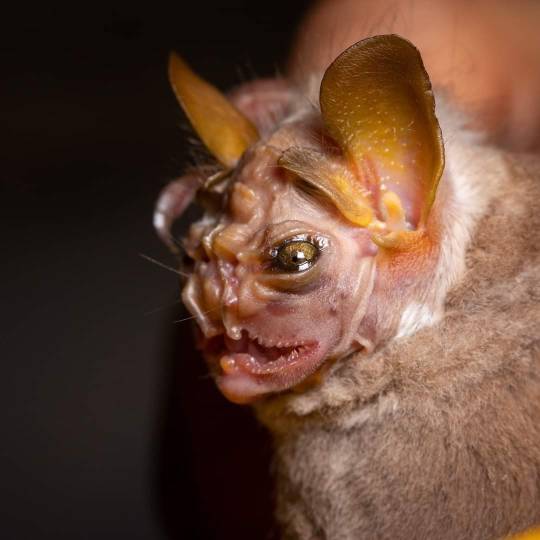
Wrinkle-faced Bat (Centurio senex): 70mm (2.7in). This might look alarming, but fear not, this species of bat is a frugivore, meaning fruit is on the menu… not blood. Found in Central and South America, this bat prefers to suck the juices from overripe fruits like mangos and soft bananas. Scientists think that the deep folds or “wrinkles” on this bat’s face help channel extra juice to its mouth while it feeds. Males, who typically have more folds than females, also have scent glands in their “wrinkles.” Amazing photo taken by Jason Headley in Belize.
source: Happy Hippie
69 notes
·
View notes
Text
Animal of the Day!
Honduran White Bat (Ectophylla alba)
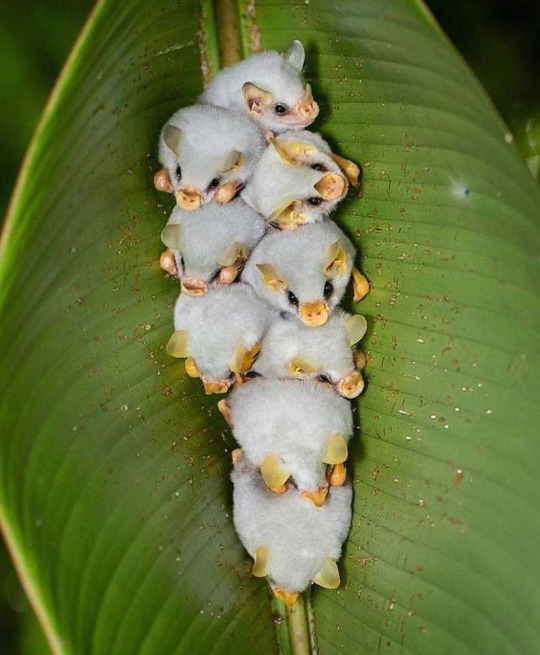
(Photo from WordPress)
Conservation Status- Near Threatened
Habitat- Southern Central America
Size (Weight/Length)- 4.5 cm
Diet- Fruit
Cool Facts- The leaf-cuddling Honduran white bat made quite the rounds on the internet due to their adorable sleeping arrangements. During the day, these bats group together in ‘tents’ made out of leaves by cutting them open in the midrib with their teeth. The tents are constructed by multiple bats and are lived in for multiple weeks until the leaf dies. Colonies usually consist of 1-15 individuals and their offspring. The leaves give further protection from predators by making the Honduran white bat’s fur appear green when sunlight casts onto the leaf. These bats feed almost exclusively on figs. The yellow carotenoids in the fruit result in the yellow coloration on the bat’s nose and ears, resulting in the Honduran white bat being one of the only mammals to have coloration based on their diet.
Rating- 14/10 (Baby bats are called pups. Bat puppies.)
#animal of the day#animals#mammals#bats#thursday#september 14#honduran white bat#biology#science#conservation#the more you know
581 notes
·
View notes